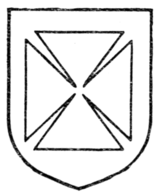THE SO-CALLED ORDINARIES
129
(Fig. 169), the cross potent (Fig. 170), the cross patée or formée (Fig. 171), the cross patonce (Fig. 172), and the cross crosslet (Fig. 173).
Of other but much more uncommon varieties examples will be found of the cross parted and fretty (Fig. 174), of the cross patée quadrate (Fig. 175), of a cross pointed and voided in the arms of Dukinfield (quartered by Darbishire), and of a cross cleché voided and pometté as in the arms of Cawston. A cross quarter-pierced (Fig. 176) has the field visible at the centre. A cross tau or St. Anthony's Cross is shown in Fig. 177, the real Maltese Cross in Fig. 178, and the Patriarchal Cross in Fig. 179.









